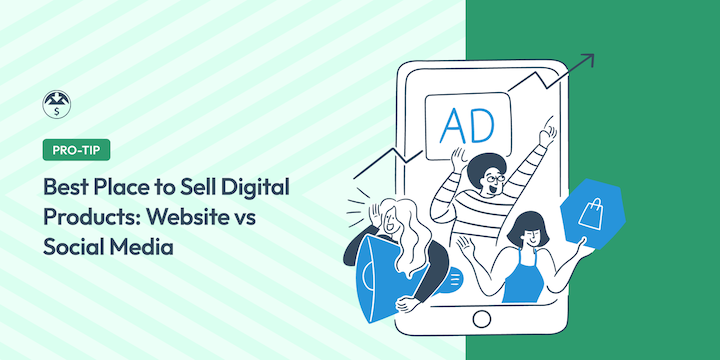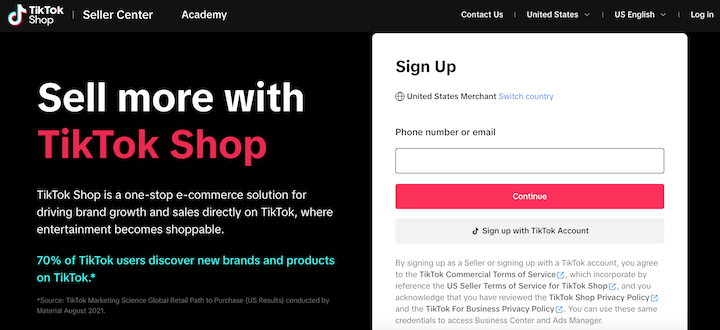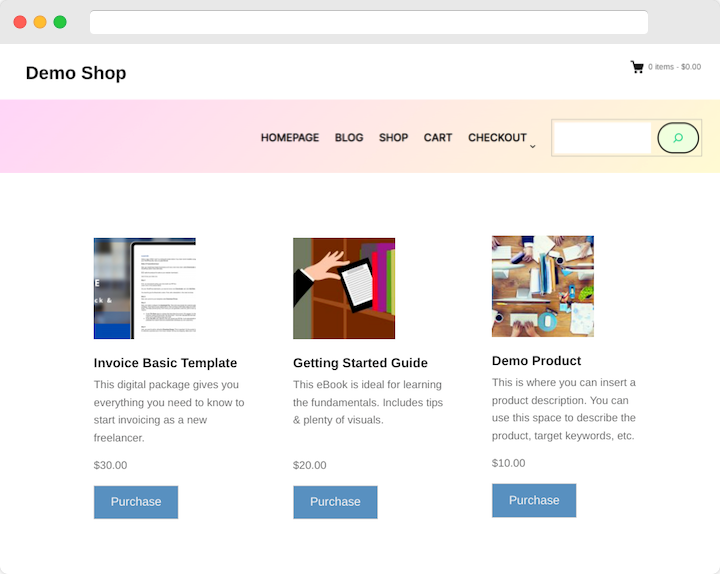
Are you trying to determine the best place to sell digital products?
If you’re new to eCommerce, you might find yourself struggling to decide where to sell your products. Two of the most popular options are creating your own online store or selling through a third-party social media platform.
🔎 In this article, I’ll cover:
Website vs Social Media Overview
So you’ve created amazing digital goods – eBooks, design templates, music, online courses, digital art, etc. – and you’re eager to share them with the world. But the big question remains: where to sell them?
The two main options you’ll likely consider are creating your own website using WordPress or another platform or selling on social media platforms like Instagram Shop or TikTok Shop.
Creating and managing a website storefront to sell online gives you complete control over your brand, store design, and customer experience. Social media platforms leverage the built-in audience and engagement features of social media to get your products in front of potential buyers.
Selling on social media platforms, also known as social commerce or social selling, is booming. But while it offers advantages like built-in audiences and engagement, it has limitations compared to selling through your eCommerce platform.
Both options have their pros and cons. The best fit for your online business will depend on your specific goals, target audience, and resources. Let’s delve deeper.
Social Selling Pros & Cons
There are many benefits to social selling. Platforms like TikTok and Instagram are pushing live shopping features, where content creators can sell directly to viewers:

AI-powered chatbots and automated messaging can offer personalized customer service and product recommendations.
Videos, pictures, and stories can be directly linked to product pages (also referred to as shoppable content) for seamless buying experiences. It’s also an excellent way to tap into an existing user base actively browsing and shopping on the platform.

Beginners may be drawn to social commerce because it requires less setup and management compared to a website. However, this initial convenience also means limited control. When selling on social platforms, you’re restricted to that platform’s guidelines and design restrictions.
For instance, TikTok Shop requires sellers to seek approval for any products in their Restricted or Prohibited Products Guidelines. As of right now, you’re not able to sell digital products, just physical goods.
You’ll also deal with transaction fees that can impact profits. In addition to depending on the platform algorithms and trends to reach your audience, your brand identity may get diluted.
Selling On Your Own Website Pros & Cons
Having your own website offers unique advantages—especially for selling digital products and digital content—over social media apps.

First, there’s more content flexibility. A website builder helps you create, design, and customize your site with ease, without any coding or technical knowledge.
You can easily showcase unlimited products with in-depth descriptions, conversion-optimized landing pages, customer testimonials, etc., and in ways that you can’t on social media.
Whether you’re selling physical products or digital files, your own website lets you personalize and optimize the checkout experience. You customize everything – branding, layout, pricing, features, fonts, formats, etc. There are no limits on product offerings or customer base.
While you may need some financial investment to get started, it’s also incredibly affordable. WordPress is the best platform and it’s free. WordPress hosting plans start at a few dollars per month. Beyond that, you’re able to determine what to invest in on an as-needed basis.
💡 Learn how to start an online store in WordPress for free.
For instance, Easy Digital Downloads is an eCommerce plugin that lets you turn your small business website into a fully functional online store. In addition to the free plan, you can upgrade to a paid license for more advanced functionality, like the ability to create a membership site and implement subscription pricing models for recurring revenue.
There are hundreds of marketing tools and integrations available, including plugins for SEO, email marketing, analytics, and more. Choose from multiple payment options via payment processing gateways like Stripe and PayPal.
Website vs Social Media to Sell Digital Products (Compared)
| Social Pros ✅ | Social Cons✖️ | Website Pros ✅ | Website Cons✖️ |
|---|---|---|---|
| Large existing user base | Some platforms (like TikTok Shop) don’t support direct digital product sales | Ideal for both physical and digital products | Higher upfront costs & time |
| Low barrier to entry | No customer data ownership | Own & collect customer data | Lower initial reach |
| Leverage creators/influencers | Dependence on platform | Full customization & flexibility | Ongoing maintenance |
| Seamless shopping & payment processing | Limited design customization | Complete control over design, features, pricing, etc. | No built-in audience |
| Visual appeal | Sales & transaction fees | Free & premium themes, templates, extensions, etc. | Responsible for marketing & customer support |
| Community building | High competition | SEO benefits | |
| Built-in marketing tools | Short attention spans | Trust & credibility | |
| Limited product showcase | Unlimited products & scalability | ||
| Higher profit margins | |||
| Expanded marketing channels (display ads, affiliates, email, social, etc.) |
Final Verdict: Best Way to Sell Digital Products
Ultimately, the best choice for you depends on your individual goals, resources, types of products, and comfort level. The most important factor is taking action and getting your digital products out there.
That said, I recommend treating social media as more of a supplement to—rather than a substitute for—an eCommerce website.
A professional, high-quality website makes your business look more legitimate and trustworthy. You have more space to tell your brand story and explain why customers should choose you.
Plus, websites tend to rank higher in search results, so people are more likely to find you. You can capture email addresses to build your marketing list and track traffic and visitor behavior to see what’s working and what’s not.
Overall, the future of social media selling is promising. However, for long-term success and control over your brand and profits, building your own website remains the recommended strategy.
Tips for Combining Your Website & Social Media
Websites are designed to convert visitors into customers, whereas social media is more for engagement. There are plenty of strategies you can use to combine the power of both.
1. Create Your Site With WordPress & EDD
Start with a simple website and build on it as your business grows. You don’t need to be an expert graphic designer or web developer to bring your product ideas and online store to life, either.
Use WordPress and Easy Digital Downloads (EDD) to create your website. While WooCommerce is a popular plugin for selling physical goods, Easy Digital Downloads is ideal for selling digital goods with ease.

This all-in-one platform for digital selling can be used for everything from stock photos, planners, and presets to eBooks, webinars, and software. Check out the video below for step-by-step guidance on getting your EDD store set up:
You can also purchase SiteGround’s Managed EDD hosting which gives you everything you need to get started. In addition to Easy Digital Downloads, that includes a free SSL certificate, domain registration, and more.
If you decide to try selling on social platforms, some, such as TikTok Shop, let you integrate your online store.
2. Use Social Media to Build Relationships
There are various ways to use social media to drive traffic to your website, expand your reach, and engage with your target audience. Utilize these channels to build relationships with potential customers and increase trust.
Consider using influencer or affiliate marketing to encourage satisfied customers to share testimonials, product tutorials, and recommendations to amplify your reach and social proof.
3. Offer Incentives to Social Media Followers
Another way you can incorporate your eCommerce website and social media to boost sales is to offer exclusive discounts, coupons, or bonus content on your website to incentivize social media followers.
For instance, EDD’s Social Discounts extension lets you reward customers for sharing products with their own social media followers:

In addition to targeted social media ads, consider using a WordPress plugin like RafflePress to run online contests and giveaways:

This can help generate buzz around your brand and make it easier to reach new audiences.
4. Leverage Different Social Platforms Strategically
When incorporating social media into your eCommerce marketing strategy, it’s important to consider and utilize each platform’s strength. For instance, Instagram is excellent for visually appealing products whereas Facebook may be better suited for targeted ads and community building, etc.
5. Track and Analyze Your Results
As with any type of digital marketing, it’s important to monitor and analyze key metrics to assess your performance. There are plenty of analytics tools you can use for both your website and social media. MonsterInsights is the best plugin to integrate your WordPress site with Google Analytics.

Most social platforms come with some type of built-in analytics. Easy Digital Downloads also comes with reports you can access directly from your dashboard. Consider engagement metrics and sales data to understand what’s working and adapt your strategy accordingly.
FAQs on Best Place to Sell Digital Products
Let’s wrap up with some frequently asked questions about selling digital products on your own website and through social media.
What is the best platform to sell digital products on?
Numerous options exist. It depends on your product and audience. Your own website using WordPress & Easy Digital Downloads, marketplaces like Etsy, social media platforms like Instagram Shop, and dedicated platforms like Gumroad, Shopify, or Sellfy are all possibilities. Research what suits your goals and audience.
What’s the role of social media in eCommerce?
It’s a powerful traffic driver and engagement tool. Use it to build brand awareness, connect with customers, and direct them to your website or specific product pages.
Can I sell digital products on a website & social media?
Yes. They can complement each other effectively. However, I would recommend that you consider building your website first to avoid platform dependence. Also, it’s important to note that, as of right now, certain platforms don’t support the direct sale of digital products.
Create a Website to Sell Digital Products
There is no single best platform to sell digital products. However, websites offer complete control, branding, and higher profit margins. While social media may be easier to start with, it has limitations in customization and long-term profits.
Analyze your needs, product, and audience to find the ideal solution for selling your digital products successfully.
Ready to build an online store within minutes? Grab an Easy Digital Downloads pass today and have your site up and running in no time:
What’s next? Learn how to boost sales with upsells and cross-sells!
📣 P.S. Be sure to subscribe to our newsletter and follow us on Facebook or Twitter for more WordPress resources!
Using WordPress and want to get Easy Digital Downloads for free?
Enter the URL to your WordPress website to install.
Disclosure: Our content is reader-supported. This means if you click on some of our links, then we may earn a commission. We only recommend products that we believe will add value to our readers.
Excellent article! Will try these places to sell my services.